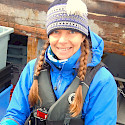
Marine Invasive Alien Species in Arctic Waters
Joint CAFF/PAME Project on Marine Invasive Alien Species in Arctic Waters
The Marine Invasive Alien Species in Arctic Waters project aims to contribute to the implementation of the Arctic Invasive Alien Species Strategy and Action Plan (CAFF/PAME, 2017) by improving the knowledge base on specific actions in ARIAS that focus on the risk of potential transfer of alien invasive species by ships via ballast water (BW) and biofouling (BF) into and within Arctic waters.
The project will compile a list of known non-indigenous species, including their current distributions, in Arctic waters.
Presently, most Arctic states have data and knowledge that can be included directly in the project, which will also include a list of data sources.
Furthermore, the project will review methods and tools used for risk assessment of invasive species, vectors, and pathways, and identify those best suited for the project’s risk assessments, as well as an assessment of the probability of nonindigenous species to be transferred by ships into Arctic waters, and between different ecoregions in the Arctic, presently and in the year 2100.
Experts
Lead Working Groups
CAFFPAME
Lead Arctic States & Permanent Participants
CanadaThe Kingdom of Denmark
 Arctic Council Working Group
Arctic Council Working Group 








